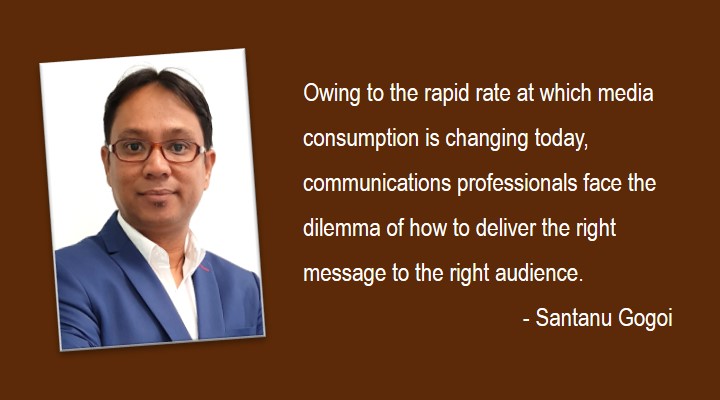Skillful communicators are on a constant lookout for innovation in determining positive, sustained outcomes for the brands and institutions they represent, whether they work on the brand side or the consultancy side. A process of learning and discovery, this task, however, suffers from reducing incremental margins over time. After all, just how many new tools can we keep discovering to address the businesses needs and demands.
The biggest demand from businesses today is to ensure predictable outcomes while navigating a hyper-fluid environment. Communicators are often called upon to help guide the choppy straits. However, while being trained to streamline turbulence, most communicators are not at peace when asked to justify communication spends and their effect on business results. It is in this context that an area where innovation would be most welcome, it would be for forging a connect between communication and business results. Innovation need not always be about finding new tools but could also emanate from new applications of existing tools.
Central to all communication programmes are the media strategies. Message without the medium has no existence. Media is the lifeblood of all communication programmes. While there are stories galore of media innovations and the emergence of new media forms, whether these creative pursuits have delivered business results for their creators has always been an open question. Many a times, campaigns are created to win awards and demonstrate creativity, but are divorced of business success. In our experience, communicators can do a lot with media to deliver business results. Media innovation here does not thrive on far-out creativity but old reliable rationale. Let’s discover how.
The public relations business had to somewhat reinvent itself in the 21st century led by the proliferation of mediums spawned by the Internet which, while making it easy to put out a message, has also complicated the task of making it heard. Indeed, given the clutter of mediums today, brand message delivery campaigns often run the risk of desensitising readers, viewers and listeners, albeit it is equally true that a message that goes viral often enough makes for intriguing possibilities!
To begin with, the smarter consumers, have more choice, listen to what’s relevant and their ability to filter the clutter is far better than ever before. This intriguing possibility also present communications professionals with an existential dilemma: how to deliver the right message to the right audience? It’s a dilemma of gargantuan proportions because of the rapid rate at which media consumption is changing today.
Like it is with all mysteries solved, media’s deployment as a business success tool is based on four finite dimensions. These are business goals, the audience, the message, and the media.
The first task for a communicator is to nail down the business goal they would like to impact. The goal must be detailed out so vividly that there is no ambiguity on the results to be achieved. It should be clearly measurable with enough detail on what failure would look like if the goals were not to be achieved.
The second aspect is to identify the audience who hold the key to business success. Behind all business results are homogenous sets of people who if enrolled would act to make the desired goal a reality. These could be consumers who would buy products, investors who would put the money on the table, employees who would take up jobs, policy makers who would believe in a process or a cause etc. We need a lot of details about the audience – from what they like, dislike, issues of importance to them, issues they abhor etc. Most importantly, their media habits and the dreams they live for should be clear and narratable. Only when you know where to get the audience and in which frame of mind, can you get into their consideration set.
The third dimension is the message. It goes without saying that while brands often align messaging to a master brand message, in the current context, each message might have to be stated differently to suit a particular business goal, the audience group and the method of dissemination.
The last dimension is the medium, and the easiest one. When we fully know the first three dimensions, the choice of medium becomes obvious. Gone are the days when television, radio or a newspaper was enough to reach your audience. The communications business is increasingly cognizant of choosing the right platform to achieve the most desirable business outcomes.
For example, a campaign could use text messaging as a way to target younger people, switch to an email campaign for parents of these young people and rely on traditional newspaper stories to reach the masses. Ditto for the master brand and its sub brands or national markets and local markets.
As another example, if the business goal is to attract talent, depending on who the talent is and where they reside, a campaign need not be put into the most popular mass media outlets, but focused on niche platforms with a more direct reach. With government stakeholders, a more direct communication is what gets best results, along with reverberating what the citizen communities feel about an issue.
Supporting technologies and expertise like econometrics, artificial intelligence, analytics and machine learning are all contributing to help manage media outcomes that align well with a brand’s strategic business priorities. This has also given wing to achieving greater accountability so vital to for brand managers trying to achieve desirable business outcomes through their media campaigns that involve huge amounts of data and decisions executed in small timeframe.
Lastly, it is the interplay among the four dimensions of media-for-business-success which needs to be carefully weighed and analysed to zero in on the right choice. This makes the mystery confounding as there would always be many answers to one problem, and the right strategist will choose a course using gut and experience. This is where our experience with media innovation is just beginning.
The views expressed here are that of the author and do not necessarily reflect that of Reputation Today.



Be the first to comment on "Reinventing media strategies for business success"